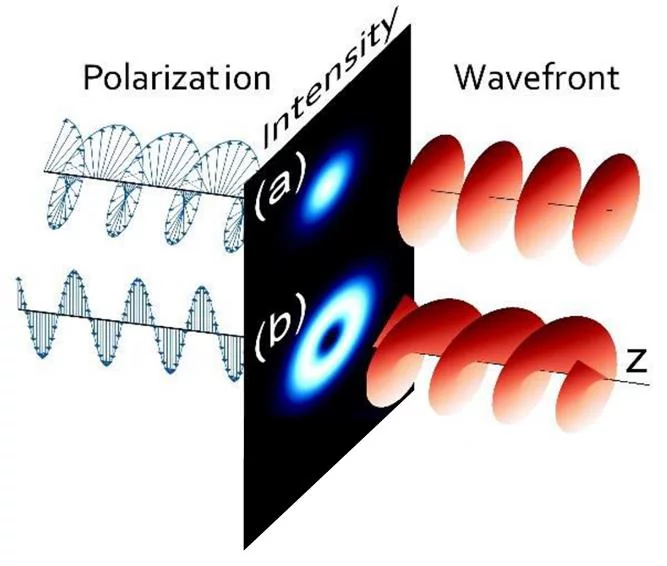A new Dichroic Effect using Beams with Orbital Angular Momentum
Light is a privileged tool to both drive and analyze the time evolution of magnetic materials in pump-probe experiments. Photons carrying a spin angular momentum (SAM) with charge equal to σℏ, with σ = ±1 corresponding to left or right circular polarization (Fig. 1a), have been used intensely for decades in circular dichroism experiments to discriminate and study the magnetic properties of materials, as well as the chirality of chemical enantiomers. It is less common in magnetic dichroism studies to exploit the fact that a photon beam can also carry an orbital angular momentum (OAM) with topological charge equal to ℓℏ (with ℓ ϵ ℤ), which corresponds to featuring a helical wave front (Fig. 1b). Such OAM beams, also called “light springs”, show a well-defined handedness analogous to circular polarization. However, the associated magnetic helicoidal dichroism (MHD), stemming from the different optical properties for beams with OAM values of opposite charge, remained up to now mainly the object of theoretical studies.
First Experimental Proof of Magnetic Helicoidal Dichroism
An international team of researchers from France, Italy, Switzerland and Slovenia was able to bring the first proof of magnetic helicoidal dichroism in an experiment at the DiProI end-station of the FERMI free-electron laser. This was possible measuring the resonant scattering close to the Brewster extinction condition with OAM-carrying light.
Well-defined OAM values were imposed on the incident beam by using spiral zone plates that were designed and fabricated at the Paul Scherrer Institut (Fig. 2a). The sample was a ~15 μm wide Fe-Ni disk (Fig. 2b), whose shape was designed to form at its center a clean remanent magnetic vortex with reconfigurable clockwise (CW) or counter-clockwise (CCW) circulation. The MHD for several OAM values (ℓ = ±1 in Fig. 2c,d) was obtained by taking the difference divided by the sum of two images of the scattered intensity collected for CW and CCW magnetic vortices. The experimental results compare extremely well with calculations based on recent theoretical models (Fig. 2e,f), providing a sound basis for future applications of magnetic helicoidal dichroism.
Vast Potential for Future Experiments
MHD represents a novel approach in magneto-optics, highly promising for studying complex spin textures, e.g. in topologically protected magnetic structures. It will also help designing new devices that can be used to either impose or probe the OAM of light beams. Moreover, many applications based on angular momentum transfer can be envisaged, from data encoding and processing to magnetization control, that exploit the unlimited orbital momentum ℓℏ of an OAM beam (where ℓ can take any positive or negative integer value) compared to the spin value σℏ of circularly polarized photons (where σ can be only ±1).
Contacts
Benedikt Rösner (Optical design)
Laboratory for Non-Linear Optics
Paul Scherrer Institut, Forschungstrasse 111, 5232 Villigen PSI, Switzerland
Telephone: +41 56 310 2454, email: benedikt.roesner@psi.ch [English, German]
Christian David (Fresnel zone plate fabrication)
Laboratory for X-ray Nanoscience and Technologies
Paul Scherrer Institut, Forschungstrasse 111, 5232 Villigen PSI, Switzerland
Telephone: +41 56 310 3753, email: christian.david@psi.ch [English, German]
Original Publication
Observation of magnetic helicoidal dichroism with extreme ultraviolet light vortices
Mauro Fanciulli, Matteo Pancaldi, Emanuele Pedersoli, Mekha Vimal, David Bresteau, Martin Luttmann, Dario De Angelis, Primož Rebernik Ribič, Benedikt Rösner, Christian David, Carlo Spezzani, Michele Manfredda, Ricardo Sousa, Ioan-Lucian Prejbeanu, Laurent Vila, Bernard Dieny, Giovanni de Ninno, Flavio Capotondi, Maurizio Sacchi, Thierry Ruchon
Physical Review Letters 128, 2022, 077401 (7 pp.)

